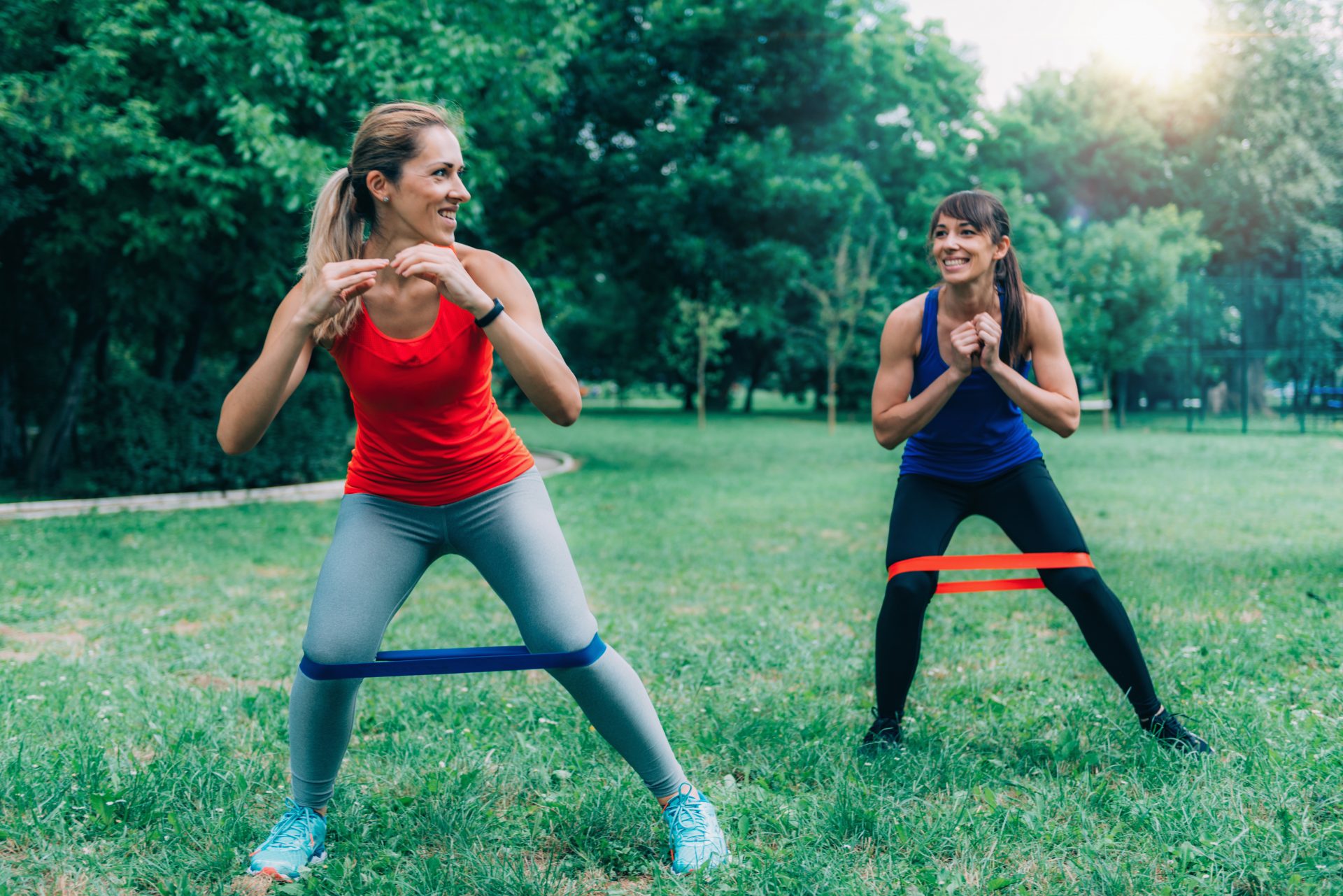Love walking? Then you *need* to do these 5 physio-approved hip exercises

Do you struggle with pain, tightness and discomfort in your hips when you go walking? Try these expert-recommended exercises to help prevent and relieve hip pain.
A few weeks ago, I started experiencing some hip pain while on my daily lunchtime walk and was instantly alarmed. Hip issues are for people over 60, not young, relatively fit people like me, right?
Wrong. After a quick Google search, I discovered that sore hips are increasingly common among people under 40, particularly since the start of the pandemic. This is due to prolonged periods of sitting, questionable work-from-home environments and new exercise routines.
What’s worse, women tend to be more susceptible to hip problems. “Genetically, we have wider hips which can affect the way we bear load through our lower extremities,” says physiotherapist Samantha Williams.
Williams explains that the hip is the largest weight-bearing joint in the body and is a crucial part of our trunk and core. This means that having good strength and control in the area is crucial.
“The hip joint provides a large range of motion which allows you to walk, run, squat, lunge, jump and so on,” she says. “It also provides you with a lot of power and force, so whether you’re mildly active or very sporty, keeping your hips happy and strong should be a priority.”
This got me thinking, I’m extremely conscious of my posture and I do my best to look after my knees, but I don’t pay near enough attention to my hips. So, I turned to the experts to find out more about why so many of us struggle with hip pain, why it’s exacerbated when we walk, and what we can do to reduce that pain and strengthen our hips.
Why do we get hip pain?
Too much sitting
Due to the complex nature of the ball and socket joint and the multiple structures that surround it, there are many potential causes of hip pain, says physiotherapist and personal trainer Tim Blakey. One of the most common, though, is excessive sitting – as we’ve already touched on.
According to Blakey, our sedentary lifestyles can cause an imbalance and deconditioning of the hip muscles. “Long periods of sitting and a lack of exercise can cause the hip flexor muscles to become tight and achy while the muscles designed to counter their force – the glutes – sit idle for too long and become weak and unconditioned,” he explains.

Overdoing it
On the flip slide, too much exercise can also lead to hip ache. If you’re pushing yourself too hard, you’ve suddenly increased your activity levels or you’re not warming up correctly, your hips may well suffer, says Williams.
“It’s about being realistic with what you’re asking your hip to do,” she continues. “If you go from doing minimal exercise to training every day, which many people did during the lockdowns, the demand will be too high and you could cause injury, inflammation, irritation or exacerbate an underlying issue.”
Overuse could also lead to conditions such as Greater Trochanteric Pain Syndrome (GTPS). “This occurs when the tendons of one of the gluteal muscles get irritated where it is attached to the top of the femur,” explains Jodie Breach, national physiotherapy lead at Nuffield Health. “It’s normally caused by an increase in activity that our muscles aren’t prepared for, but also seems to be affected by hormone levels, with women of menopausal age being particularly vulnerable.”
Another common condition associated with overdoing it is hip tendinopathy, a repetitive stress injury which affects the outer part of the hip, causing pain and inflammation to the area.
Ligament laxity and genetics
Ligaments are the passive structures that support a joint and attach one bone to another, explains Stefanie Yeh, lead physiotherapist at Ten Health & Fitness. “Some people are genetically predisposed to have more laxity (stretch) in their ligaments compared to others, which can lead to feelings of joint instability and pain,” she says.
Williams points out that women tend to have more ligament laxity than men, and this often increases during our periods and pregnancy.
Bone and cartilage problems
“As the primary function of the hips is to absorb and support our weight throughout our lifetime, they can be particularly susceptible to joint-related conditions like osteoarthritis, labral tears and femoroacetabular impingement,” explains Yeh.
Why does hip pain get worse when we walk?
It’s often down to muscle weakness or imbalance around the hip, says Yeh. “The hip muscles, specifically the glutes, have a responsibility to stabilise the joint and keep the hip and pelvis level when standing, walking or running,” she explains. “If we have insufficient activation of these muscles when walking, we may experience a ‘hip drop’, where the opposite hip drops lower than the hip on the standing leg. This puts an undesirable strain on the structures around the hip joint and lower extremities, and can lead to pain and discomfort.”
Blakey agrees, adding that tight hip flexors combined with inadequate core control and weak glutes can cause the lower back to arch excessively. “The repetitive action of walking has the hips hanging on the tight hip flexors trying to stabilise the joint without much assistance from elsewhere.”
5 hip-strengthening exercises to reduce pain while walking
The experts all agree that the best thing you can do to reduce and prevent hip pain is to focus on improving strength and stability around the hip through exercise. Here are some moves to incorporate into your daily routine – whether you’re currently struggling with hip pain or you want to avoid problems further down the line.
Bear in mind, if you’re experiencing hip pain when walking and you think it’s due to overuse, it’s advisable to slow down and be mindful of your activity levels so you don’t further aggravate the symptoms. “You don’t need to stop exercising altogether as this will contribute to you losing muscle strength but it is advisable to modify what you’re doing to make it manageable,” says Breach.
BANDED FOUR-WAY HIP EXERCISES
For Williams, banded four-way hip exercises are a great way of activating and strengthening the muscles around the hips. They work on flexion, extension, abduction and adduction.
- Tie a resistance band to a table leg, making sure it’s secure, then loop the band around your right ankle.
- Stand parallel to the table with your core engaged and your shoulders down.
- Kick your right leg backwards slowly then bring it back to the centre in a controlled way. Try to keep your feet from touching the ground if you can.
- Repeat this 10 times then turn to the right.
- Kick your leg out to the side slowly for 10 reps. Try not to lean to one side and if you can, keep your foot off the ground.
- Rotate 90 degrees so you’re facing away from the table, then kick your leg forward for 10 reps.
- Finally, turn to your left side. Keeping your back straight and your hips level, slowly kick your leg out across your body for 10 reps.
- Repeat the entire sequence on the opposite leg.
“I’d recommend following this with single-leg work like step-ups or some squat variations, which are always great for hip strengthening,” says Williams.
GLUTE BRIDGE
“Strong and adequate hip extension is necessary when we walk and run to help propel the body forwards,” says Yeh. As the glutes and hamstrings work to extend the hip, strengthening these muscles is crucial. One exercise she recommends to help with this is the glute bridge.
- Lie on your back with your knees bent and your feet hip distance apart.
- Using your lower abdominal muscles, tilt your pelvis backwards so your lower back flattens slightly onto the ground.
- Keeping this pelvic tilt, lift your hips up off the ground as high as is comfortable, aiming for a straight line from the shoulders to the hips and the knees. Gently squeeze your glutes at the same time.
- Hold for a few seconds at the top before lowering back down, trying to maintain that pelvic tilt.
- Un-tilt the pelvis and repeat for 10-12 reps.
“If you want to take things further, you can try single-leg glutes bridges to recruit the gluteus medius and minimus further and work on your hip stability a bit more,” says Yeh. Adding some load will also increase the challenge.
STANDING BANDED MARCHES
A good exercise to do before you go walking, says Blakey, is standing banded marches. “It wakes up the surrounding musculature, brings balance and stability to the hips and relieves some of the tight pressure in the hip flexors.”
- Step your feet into a resistance band so that it sits around the balls of your feet.
- Keeping the toes flexed up towards your shin, raise one knee as high as you can without allowing your other knee to bend.
- Brace your core by drawing your belly button in and tucking your tailbone under. Make sure you don’t allow your lower back to curve too much during this movement. If balance is tricky, lightly hold on to something stable nearby.
- Once the knee is raised as high as possible, roll the thigh outwards.
- When you have turned your hip out as far as you can, lower the raised leg back to the ground.
- Repeat for 8-10 reps before moving on to the other side.
“Exercises like this should be complemented with a strength programme that incorporates all the fundamental movement patterns including squats, lunges, deadlifts and hip thrusts,” says Blakey.
CRAB WALKING
According to Breach, crab walking is a simple but effective move that can help to ease hip ache, strengthen the hip abductors and maintain pelvic alignment while standing, walking and running.

- Get into a mini squat position with a resistance band around your thighs, ankles or toes. The lower the band, the more muscle activity you’ll get at your hips, so choose depending on how hard the exercise feels.
- Maintaining that mini squat position, take small steps sideways against the resistance of the band.
- You should start to feel it working on the outside of your hip, strengthening your lateral glutes.
- Repeat for 8 to 12 reps on each side, completing between three and five sets in total.
STEPS-UPS
Another great strengthening exercise which targets the glutes, hamstrings, adductors and hip flexors is the step-up, says Breach.
- Step up onto a high box or a step, moving slowly so you’re working on gaining strength and control around your hip.
- Keeping your core engaged, your shoulders back and your head tall, slowly lower yourself back down to the ground.
- Perform 8 to 12 reps on each leg and aim for three to five sets in total.
To increase the challenge and strengthen the hip joints further, you could try holding onto some dumbbells while you perform the move.
Can stretching help with hip pain?
You may have heard that stretching will help alleviate sore, painful hips but this isn’t always the case. “Increasingly, we’re finding that stretching isn’t the answer to hip problems, with evidence showing that strength training is actually much more beneficial for hip health,” says Williams.
Yeh warns that in some cases, stretching certain muscles of the hip can actually exacerbate and even worsen hip pain. “If your muscle pain or tightness is due to an underlying strength or stability defect rather than true muscle shortness or stiffness, it can be counterproductive.
“It’s best to consult a healthcare professional who can guide you as to whether certain stretches would be beneficial depending on the cause of your hip pain,” she adds.
Outside of strength training exercises, Yeh recommends pilates, which she says is an excellent way to build a strong foundation around the hips while improving your hip and core stability. “Using a foam roller or trigger point ball can also be beneficial in promoting blood flow and circulation to certain structures around the hip while releasing muscle tightness or trigger points.”
When should you see a GP about hip pain while walking?
It’s important to recognise that if your hip pain is persistent or becomes severe, you should seek professional advice from a medical practitioner like a physiotherapist, advises Yeh. “They will be able to perform a thorough assessment to properly diagnose the specific cause of your pain.
“Seek medical help if the pain occurs when you rest, if it wakes you up at night, if it occurs simultaneously with lower back pain, or if it hasn’t settled after a few days of resting.”
Images: Getty
Source: Read Full Article